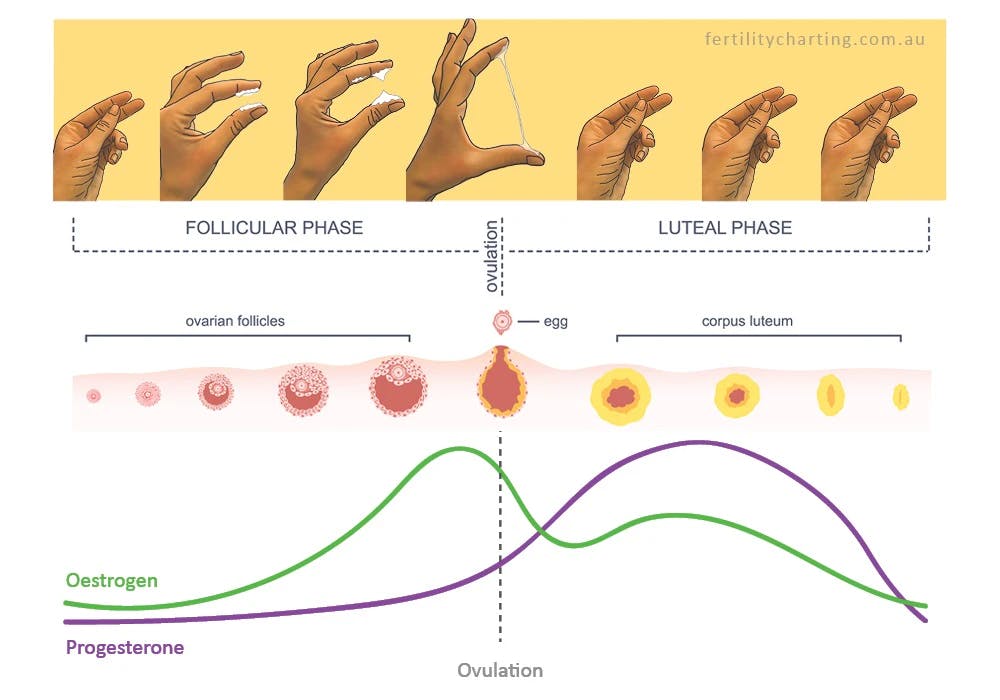Everything You Need To Know About Cervical Mucus, A Biomarker Of Your Fertility
As young women, seeing our favorite pair of underwear ruined or noticing a clear, gel-like or thick, creamy substance when you go to the bathroom can be somewhat concerning. When we’re uneducated about our bodies, any new experience can be a cause for worry.

But noticing these substances shouldn’t be an anxiety-inducer at all. In fact, the presence of what some would call vaginal discharge (also known as cervical mucus or cervical fluid) gives a girl every indication that her reproductive health is exactly where it should be. Your cervical mucus is actually Mother Nature’s perfect measure of how to gauge where you are in your cycle, though you might not know exactly how to use it as an indicator of health. Here’s everything you need to know about cervical mucus.
Cervical Mucus Is Crucial to Fertility and Body Literacy
It might sound gross or off-putting, but cervical mucus, in reality, is an incredible function of our female bodies. It’s unique to our reproductive system and ours alone, and varies and fluctuates according to where you are in your cycle. Because of this, it’s crucial to the strength of our fertility – and remember, fertility is important whether we’re trying to get pregnant or not!
The fluid produced by your cervix really goes through four different stages, and each one can provide insight into your menstrual cycle and, more importantly, ovulation. An absence of cervical mucus or producing none at all means you might have just finished your period. Vaginal dryness and a lack of cervical mucus can also point to other issues, like hormonal imbalances or side effects from medication. Many women on hormonal birth control report an absence of cervical mucus, which they find hard to get back even after quitting it.
Cervical mucus goes through different stages throughout your cycle, in response to your hormones.
During the follicular phase, as your estrogen is rising and your body is preparing an egg, you might notice mucus that’s a cloudy appearance with a tacky texture, similar to glue. It can be cloudy, white, or yellow-tinted, and this type means your body is gearing up for the big event.
The mucus present during your ovulatory stage is most often described as similar to an egg white. It’s clear, sticky, and stretchy, and while you might not notice it on toilet paper after wiping or even on your underwear depending on the amount (which can vary depending on the woman), you can check for its presence by performing a quick exam. Using your index finger, take a gentle swipe through the vagina, and then evaluate the substance between your thumb and pointer finger.

Image Source: Fertility Charting
After ovulation, as estrogen drops and progesterone rises, you may experience thicker, cloudy fluid again or no fluid at all and dryness instead, and after your period, the cycle begins all over again.
You Can Use It To Get Pregnant (or Avoid Pregnancy Altogether)
You might have already figured out that cervical mucus is perhaps the biggest clue that you’re ovulating. Knowing we’re ovulating is obviously important for a number of reasons. If we’re actively trying to conceive, the presence of cervical mucus tells us when to have sex for the best chances of conceiving. If we’re trying to avoid pregnancy, we know to avoid sex when fertile cervical mucus is present.
If you’re using the presence of cervical mucus as a method of natural family planning (like the Creighton Model or the Billings Method), it’s important to become comfortable with yourself enough to perform regular exams, or become more diligent in noticing and monitoring the presence of cervical mucus when wiping (it’s important to wipe before urinating). However, any presence of cervical fluid before or after sex probably isn’t reliable, and can be attributed to arousal fluid which is not the same as cervical mucus. Arousal fluid can stretch farther than fertile mucus and also dries out very quickly.
If your cervical mucus is clear and sticky and stretches an inch or more between your thumb and pointer finger, then it’s baby-making time. The consistency of fertile mucus helps the sperm to swim and the pH helps keep the sperm alive. If you’re avoiding pregnancy and there’s a presence of this fertile fluid, then you know to avoid sex for at least two to three days.
In addition to charting your cervical mucus, you can track your basal body temperature (BBT) each day too. While the presence of cervical mucus is a positive point of reference that you’re ovulating, taking your BBT (which rises sharply at the time of ovulation, due to an increase in the hormone progesterone) can confirm ovulation after it’s happened. Relying on your BBT to avoid pregnancy will only be effective after you’ve tracked it for a few cycles and discovered the exact pattern of your cycle. Charting your BBT daily, as well as journaling the presence or absence of cervical fluid, can just as easily help you know when to avoid sex if you’re not trying to get pregnant as it can help you conceive. Low BBT temperatures can also indicate issues with ovulation and insufficient progesterone.
The consistency of fertile mucus helps the sperm to swim and the pH helps keep the sperm alive.
The science behind this is not only fascinating, but shows how effective this type of method really is. A study from the University of North Carolina evaluated women between the ages of 30 to 44 who were trying to conceive and who had histories of hormonal imbalances and reproductive disorders, such as polycystic ovarian syndrome, endometriosis, and pelvic inflammatory disorder. Participants who used the Billings Method through daily journaling of their cervical mucus, intercourse, ovulatory testing, and vaginal bleeding were found to have conceived much more quickly than those who did not.
Why Your CM Is Crucial to Your Health
When we begin to view our cycles as our fifth vital sign, seeing how our cervical mucus acts as a barometer of the wellbeing of our cycles becomes instinctive. It may feel nice or convenient to not have a period or be on hormonal birth control, but sadly, we could be sacrificing vital information about our fertility for the price of convenience.
The presence of cervical mucus not only lets us know when we’re fertile with a high chance of conceiving, but it’s also a quick, easy, and effective way to know where we are in our cycle. If we have irregular cycles or other issues which may point to a hormonal imbalance, noticing the presence or absence of cervical fluid is another piece of the puzzle.
Closing Thoughts
As women, we shouldn’t only evaluate our health based on our skin, weight, or other physical attributes, though those can be good indicators. What’s happening (or not happening) on the inside is just as significant as what’s happening on the outside. While it can be annoying to sacrifice yet another pair of cute panties to our reproductive system, we can rest easy knowing our body is working hard for us, whether we notice it or not.
Love Evie? Let us know what you love and what else you want to see from us in the official Evie reader survey.